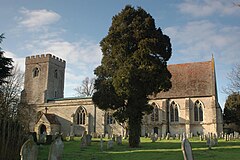Great Haseley
| Great Haseley | |
|---|---|
 St. Peter's parish church |
|
| Great Haseley shown within Oxfordshire | |
| Area | 17.61 km2 (6.80 sq mi) |
| Population | 511 (parish, including Latchford, Little Haseley, North Weston & Rycote) (2011 Census) |
| • Density | 29/km2 (75/sq mi) |
| OS grid reference | SU6401 |
| Civil parish |
|
| District | |
| Shire county | |
| Region | |
| Country | England |
| Sovereign state | United Kingdom |
| Postcode district | OX44 |
| Dialling code | 01844 |
| Police | Thames Valley |
| Fire | Oxfordshire |
| Ambulance | South Central |
| EU Parliament | South East England |
| UK Parliament | |
| Website | The Haseleys |
Great Haseley is a village and civil parish in South Oxfordshire. The village is about 4.5 miles (7 km) southwest of Thame. The parish includes the hamlets of Latchford, Little Haseley and North Weston and the house, chapel and park of Rycote. The parish stretches 6 miles (10 km) along a northeast — southwest axis, bounded by the River Thame in the north, Haseley Brook in the south and partly by a boundary hedge with Little Milton parish in the west. The 2011 Census recorded a parish population of 511.
The Domesday Book of 1086 records that a Norman nobleman, Miles Crispin of Wallingford, held the manor of Great Haseley. In the 13th century the manor was held by Roger Bigod, 2nd Earl of Norfolk. In 1332 Edward III granted Great Haseley to William de Bohun, 1st Earl of Northampton. In 1482 Edward IV granted the manor to the dean and canons of St George's Chapel, Windsor Castle.
The present Manor House was built in the 17th century, altered in about 1700 and has a Georgian stable block. It is a Grade II* listed building.
The Church of England parish church of Saint Peter dates from about 1200. The three-bay arcades linking the nave with the north and south aisles are in a Transitional style from Norman to Early English Gothic, as is an external doorway that has been re-set on the west side of the bell-tower. The chancel and its arch were built late in the 13th century, and it retains all of its Decorated Gothic windows from that time. In the 14th century each aisle was extended eastwards with a fourth bay, and at the end of each aisle is a chapel with a squint into the chancel. The northeast chapel is Perpendicular Gothic, as are the bell-tower and the clerestory that was added to the nave. The Gothic Revival architect Thomas Garner restored the chancel in 1897. St Peter's is a Grade I listed building.
...
Wikipedia

